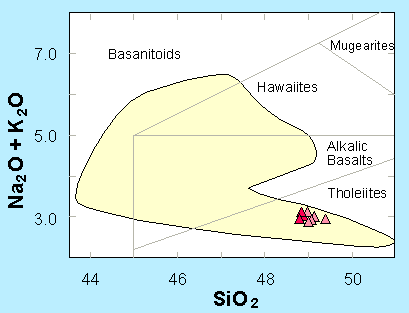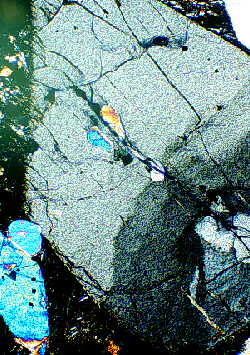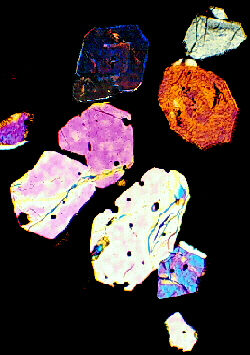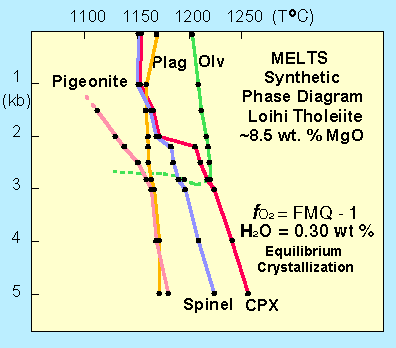
Recent Activity at Loihi Volcano

Shore-Based Studies of Rock Geochemistry Following the 1996 Eruption
Visit these Recent Activity Links Too:

In this document, you will find a summary of the results of
geochemical and petrographic
analysis of
samples recovered from Loihi after the 1996 Seismic-Volcanic Event.
The interpretations you will find here refelct the ideas of the Drs. Mike
Garcia and Ken Rubin. Come back as often as you like, as we are always
updating this and related pages with new info when it becomes available.
A Catalogue of Rocks collected on the August Event Response
expedition and some representative
Photographs are available on the
Rock Gallery Page.
Physical
and Chemical Characteristics of The Event-Response Rocks
The recent expedition to investigate the cause of the seismic event at
Loihi returned the freshest glass ever observed from this volcano.
All previous Loihi samples
have had a coating of some secondary material on the glass, produced over
time by the rock having sat on the sea floor. Several of the new samples
collected during the PISCES V dives last week are pristine.
Petrographically, these samples are weakly vesicular, olivine basalts.
This is a feature that is typical of Loihi's tholeiitic basalts. Loihi
also has erupted alkalic basalts in the past but they are usually aphyric and
strongly vesicular. Few alkalic lavas have been erupted recently on Loihi
(<5% of the surface flows; Garcia et al., 1995), suggesting that the source for
Loihi lavas is drifting closer to the center of the Hawaiian hotspot rising up
from a fixed location in the Earth's mantle. This reasoning is based on
the fact that tholeiites are produced from higher melting temperatures
in the mantle than alkalic lavas.
Results of glass margin electron microprobe analyses
All of these samples were analyzed using an electron microprobe to
determine the composition of their glass rinds. This is a rapid and reliable
method for examining the composition of submarine basalts.
The figure below shows how the composition of these new
lavas, plotted as red symbols, compare to previously analyzed Loihi lavas
(see the Data Tables below
for the complete data).
Microprobe Glass Data

Fig. 1 Glass compositions of samples from the Event Response
expedition. The freshest lavas are plotted in red,
whereas the older looking lavas are plotted in
coral. All of these
samples are classified as Tholeiitic
in composition. For comparison, the pale-yellow
field represents the range of published glass compositions at
Loihi (including both it's summit and flanks)
As is evident from the figure above and table at the end of this
document, the lavas have very
similar compositions, supporting the notion that they and could have all been
produced during the same eruption. This despite the fact that they were all
"accidental blocks" collected by the submersible from different places
along the west flank of Loihi's summit. A previous study of "in place" lavas
from this area found much greater geochemical variability (Garcia et al., 1993). These rocks are classified as tholeiitic and are somewhat different in
composition than rocks that were collected from the deeply dissected east
flank of Loihi (the various blue symbols on the figure above). They are within
the range of other previously collected Loihi lavas, however (depicted by
the pale yellow field in figure).
Not only are the lavas similar to each other, but they are also
remarkably geochemically similar compared to those we (Garcia) previously
collected from dredging and submersible sampling of Loihi. All of the
newly-collected tholeiites have nearly identical MgO contents.
The similarity in MgO content for these rocks may only reflect similar
eruption/quenching temperatures [1150-1155 deg C based on the Helz and Thornber
(1987) geothermometer for Kilauea compositions]. These temperatures are
essentially the same as those measured for lavas from the current Puu Oo
eruption of Kilauea near it's vent.
The similarity of the other elements for most of the samples indicates that
the lavas from this volcano are being homogenized. This may have taken
place in a shallow magma chamber within Loihi. The small differences in CaO
and FeO in some of the samples could be due to minor fractionation of
pyroxene. One somewhat different sample, P286-2, has lower
incompatible element contents (e.g., K2O). This indicates that its parental
magma was different from the others. It is also visually much different
than the other rocks.
Results of whole rock XRF analyses
An additional technique used to study these rocks was X-ray flourescence of
whole rock powders. This technique yields somewhat different information
than electron microprobe analyses of glasses, since the former
includes all the components of the volcanic rock (both large
mineral crystals, known as "phenocrysts", and the part of the rock that
was molten upon eruption, known as the "groundmass"). By contrast, the
electron microprobe analyses only include the quenched groundmass. We use
both approaches because they tell us slightly differnet things.
Five lavas from the Loihi Rapid Response cruise were analyzed by XRF at the
U. of Massachusetts by J.M. Rhodes, including 3 of the "fresh" glassy rocks
(see the Data Tables below for complete data).
The results for these rocks are plotted on MgO variation diagrams because
Mg-rich olivine is the main mineral present in these rocks. Whole rock
analyses are depicted as red circles.
Also plotted in red triangles are microprobe analyses of glasses from
these rocks, as well as and glasses from other Loihi Summit tholeiites
in blue (Garcia et al., 1993).
|
Note the very wide range in composition of Loihi summit tholeiites in the
two diagrams bellow as compared to the rather restricted range
for the rapid response
samples. All of the latter samples were analyzed in the same lab using the
same standards, so inter-laboratory bias is not the cause of the scatter.
|
- On the MgO - TiO2 diagram, all but one of the samples from
the rapid response cruise form a coherent trend that would be
expected for lavas that are related to a common parental magma. The
exception is sample P286-2, an older, non-glassy sample.
- If these rocks are related to the same or similar parental magma(s), then
the MgO - CaO/Al2O3 diagram shows that clinopyroxene
must be involved in the crystallization history of these magmas (in
addition to olivine) in order to lower the CaO/Al2O3
ratio (the ratio would be constant if only olivine was crystallizing from the
magma).
- Interestingly, clinopyroxene is rare to absent in most Hawaiian
tholeiites with >7 % MgO. Although these samples from the rapid response
cruise have >7 % MgO they show this unusual clinopyroxene signature.
- As we have learned from previous work, Loihi rocks are sometimes
different from other Hawaiian tholeiites, so this may not be that suprising.
To examine this further, thin sections of these rocks are being
cut to determine what minerals are
in these rocks (clinopyroxene is black like the matrix, so it cannot be
identified in hand specimen) and what their compositions are.
|

Fig. 2 Comparion of Whole Rock and Glass analyses on
samples from the Event Response expedition. The freshest lavas are plotted
in red, whereas the older looking lavas are plotted
in coral. Published data on other summit tholeiites
are plotted in blue for comparison. This latter
data corresponds to the lower-rightmost part of the
pale-yellow field in Fig. 1 above.
|
Results of Thin Section Petrography
|
Photomicrographs of Loihi Rapid Response Cruise Basalts. Photos are of
polished thin sections in polarized light with crossed polars and a
field of view about 1mm and 2.5mm, respectively.
|

|

|
Large zoned crystal of clinopyroxene (gray) with two round inclusions of
olivine (bluish green and brownish yellow). Many of the new Loihi rocks have
this feature, which indicates that olivine started to form early and then
reacted with the magma as clinopyroxene formed.
|
Crystals of olivine (pinkish) and clinopyroxene (brown, gray and dark blue)
in a glassy matrix (black). Note concentric zoning in pyroxenes.
Clinopyroxene is rare in Hawaiian tholeiitic basalts.
|
Results of Petrologic Modelling
A synthetic phase diagram was constructed using the MELTS program (Ghiorso
and Sacks, 1995) to determine what the reaction texture in the Loihi basalts
is telling us. The magmatic conditions for this model are our best guesses
for Loihi. At low pressures (<2 kb or < 6 km), olivine (green curve, "olv") is
the first mineral to form from a magma of the composition observed. The
other minerals (including "plag" - plagioclase and "CPX" - clinopyroxene)
all start crystallizing after the magma has cooled about 50oC from its initial
parental temperature. At pressures above 3 kb (9 km down in the crust), no
olivine forms (dashed green curve shows the maximum pressure
stability limit of olivine in this rock). At pressures between 2.5 and 2.8
kb, olivine forms for a short interval before it starts to dissolve as
clinopyroxene forms (red curve).

The reaction texture is telling us that these lavas were crystallizing
at depths of ~8 km before they were erupted. This is deeper than the magma
chamber under Kilauea volcano (2-6 km), its sister volcano to the north.
The presence of several pit craters on Loihi, including the new Pele's pit,
has led us to believe that Loihi's magma chamber(s) are shallow. They may
be true but this new information indicates that there is another magma
storage area deeper within Loihi that may be located near the base of the
oceanic crust, and which was a key factor for the composition of these
newer lavas.
Some Preliminary Conclusions
Based upon the above chemical and physical information, it is possible to
say that the "Fresh" glassy rocks (P286-1, -3 and -6) are probably part of one
geochemically homogeneous recent eruption (a point hopefully to be
confirmed by radiometric dating of these rocks).
These
petrographic and geochemical results support the hypothesis that these
glassy lavas were produced during a recent (July 1996) eruption of Loihi.
Further, this eruption likely occurred in conjunction with a major
collapse of its summit area. The collapse may be similar in origin to the
model proposed for the formation of pit craters on Kilauea. They are
thought to form following the lateral migration of magma within the volcano
(usually down the rift zones away from the summit reservoir; see Ryan 1988,
JGR, 93, B5, 4213). This would leave a partially empty summit reservior
whose roof was unstable and collapsed.
Microprobe Analyses of Glasses from the Event Response Expedition
|
|
DATA SOURCE:
Garcia, M. O., Rubin, K. H., Norman, M. D., Rhodes, M., Graham,
D. W., Muenow, D., Spencer, K. (1998) Petrology and geochronology
of basalt breccia from the 1996 earthquake swarm of Loihi Seamount,
Hawaii: Magmatic history of its 1996 eruption. Bulletin of
Volcanology, vol 59, 577-592.
|
Sample SiO2 TiO2 Al2O3 FeO MnO MgO CaO Na2O K2O P2O5 Total
P286-1& 48.75 2.63 13.72 11.79 0.14 6.91 12.05 2.53 0.45 0.24 99.21
P286-2 49.0 2.56 13.79 11.47 0.16 6.85 11.75 2.48 0.39 0.20 98.65
P286-3& 48.90 2.65 13.75 11.87 0.15 6.91 12.00 2.55 0.46 0.23 99.47
P286-4 48.85 2.62 13.61 11.58 0.15 7.01 12.15 2.60 0.43 0.21 99.21
P286-5 48.95 2.64 13.89 11.93 0.15 6.80 12.08 2.60 0.44 0.22 99.70
P286-6& 48.90 2.68 13.80 11.82 0.15 6.72 11.94 2.56 0.46 0.24 99.27
P287-1 49.10 2.62 13.79 11.89 0.16 6.87 11.95 2.52 0.40 0.20 99.50
P287-2 49.40 2.62 13.74 11.90 0.16 6.93 12.00 2.51 0.40 0.19 99.85
Tow-yo% 49.20 2.63 13.53 11.91 0.17 6.88 12.05 2.53 0.43 0.22 99.55
DATA NOTES:
& = samples plotted in data figure
% = glass recovered from TOW-YO cast #3
|
|
XRF Analyses of whole rocks from the Event Response Expedition
DATA SOURCE: Same as above
|
Sample SiO2 TiO2 Al2O3 Fe2O3 MnO MgO CaO Na2O K2O P2O5 Total
P287-1 47.79 2.421 12.20 13.30 0.19 9.65 11.05 2.27 0.409 0.236 99.51
P286-1A 47.41 2.430 12.29 13.34 0.19 9.44 11.14 2.25 0.428 0.240 99.15
P286-2 47.69 2.386 12.01 13.33 0.19 10.27 10.97 2.09 0.390 0.230 99.55
P286-5 47.68 2.527 12.69 13.24 0.19 8.47 11.43 2.38 0.465 0.250 99.33
P286-6D 47.85 2.542 12.85 13.23 0.19 8.19 11.47 2.37 0.448 0.254 99.40
|
|

 Return to the Hawaii Center for Volcanology LOIHI Page
Return to the Hawaii Center for Volcanology LOIHI Page
 Return to the Hawaii Center for Volcanology Home Page
Return to the Hawaii Center for Volcanology Home Page
This page created and maintained by
Ken Rubin ©,
krubin@soest.hawaii.edu
Other credits for this web site.
Last page update on 26 Aug 1998












![]() Return to the Hawaii Center for Volcanology LOIHI Page
Return to the Hawaii Center for Volcanology LOIHI Page
 Return to the Hawaii Center for Volcanology Home Page
Return to the Hawaii Center for Volcanology Home Page


